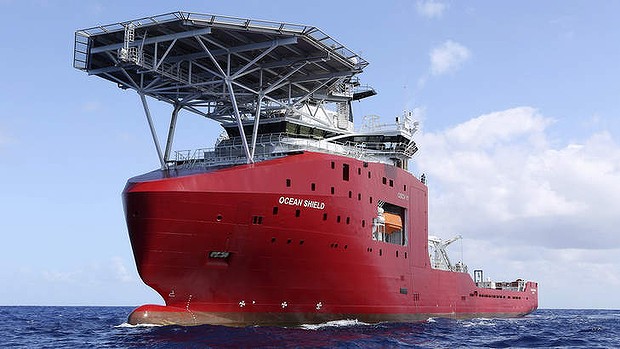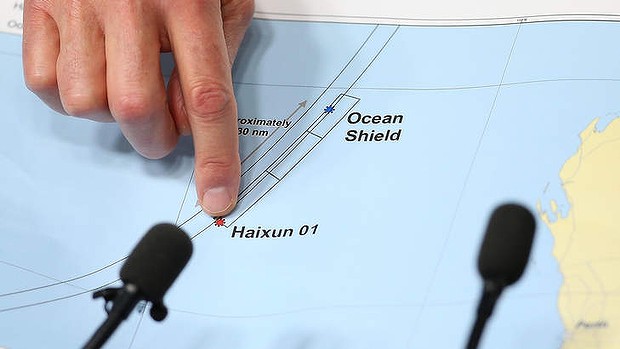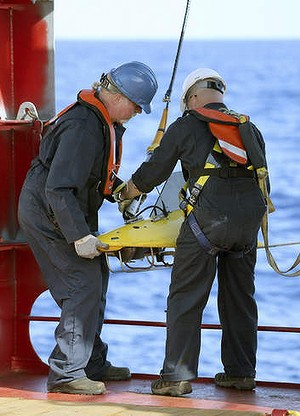
The Australian vessel Ocean Shield is towing a pinger locator to try to locate the black box from MH370. Photo: AP
Lucy Carroll, Rania Spooner
A US pinger locator has detected signals consistent with those emitted by an aircraft black box, indicating a potential breakthrough in the month-long search for missing Malaysia Airlines flight MH370.
Two separate signals have been detected by a US device being towed by Australian Defence Vessel Ocean Shield in the northern part of the Indian Ocean search area, about 1700km north-west of Perth.
In what he called “a most promising lead”, Air Chief Marshal (ret) Angus Houston, the head of the search’s Joint Agency Coordination centre, revealed that “the pinger locator has detected signals consistent with those emitted by aircraft black boxes”.
“It is the best information we have had in the search so far,” he said.
The first detection was picked up on Sunday morning and held for about two hours and 20 minutes, before the ship lost contact. The pinger locator was in relatively shallow waters at the time.
On the return leg, hours later, a second detection was held for about 13 minutes, where two distinct pinger returns were audible.
The incidents were about 1800 metres apart and could have been from the same source, or two separate sources, said Commodore Peter Leavy, the man in charge of the search.
‘‘Significantly, this would be consistent with transmissions from both the flight data recorder and the cockpit voice recorder,’’ Mr Houston said, cautiously adding that authorities were “a very long way off” verification.
“We haven’t found the aircraft yet, we need further confirmation,’’ he said.
Commodore Leavy said pinpointing the origins of the sound would be a slow, challenging process as sound waves under water can distort by as much as 90 degrees.
“It is a markedly different environment to what you see with sound travelling through air,” he said.
ADV Ocean Shield would continuing moving in a square around the 1800-metre detection zone in an attempt to relocate the signal over the next 24 hours, he said, it takes the ship about eight hours to complete a single leg.
“It is a very slow and painstaking process … if the pinger is out there and it’s still radiating we’re confident that we should find it,” he said.
The ADV Ocean Shield detection on Sunday came shortly after a Chinese patrol vessel, the Haixun One Zero, reported detecting two pulse signals on Friday night, and then again on Saturday at a frequency consistent with black box technology.
The ships are within a search area more than 300 nautical miles long, with the ADV Ocean Shield at the northern extremity and the Haixun Zero One at the southern end
Both ships are within the range analysts believe is where the plane was most likely to have entered the water. The data has been provided by expert in Malaysia working with satellite information.
“Their work has enabled us to come up with an underwater search area which is quite narrowly focused and with the acoustic events that we’re getting in the area, we ‘re encouraged that we’re very close to where we need to be,” Mr Houston said.
The HMS Echo and RAAF aircraft were diverted to the Haixun’s location on Sunday in a bid to verify whether the detections were linked to the missing plane’s black box.
Malaysian Airlines flight MH370, with 239 people on board, vanished without a trace during a routine flight from Kuala Lumpur to Beijing on March 8.
Up to 12 aircraft – nine military and three civilian, and 14 ships were scheduled to assist in the southern Indian Ocean search on Monday.
Weather conditions in the 234,000 square kilometre search area were expected to deteriorate into the afternoon after a clear day.
The Ocean Shield will continue “runs” over the search area where it detected the signals for the next 24 hours.
If the signal can be picked up again and a source location identified, a Bluefin-21 autonomous underwater vehicle would be dropped to the ocean floor to search for wreckage. The Bluefin-21 is equipped with sonar and can carry an underwater camera.
Mr Houston said it was possible that the ADV Ocean Shield and the Haixun Zero One had detected either of the plane’s two black boxes: a cockpit recorder and a flight data recorder.
“Both events are within the area of probability,” he said
“We have to prosecute both contacts, we don’t know at the moment, we don’t have any confirmation that one or the other is significant enough for us to say this is where the aircraft is.”
However, search crews are racing against the clock, with the batteries powering the black boxes’ signals already past their minimum lifespan.
Courtesy: www.smh.com.au



Leave a comment